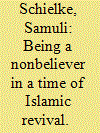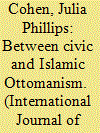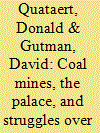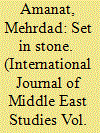|
|
|
Sort Order |
|
|
|
Items / Page
|
|
|
|
|
|
|
| Srl | Item |
| 1 |
ID:
113397


|
|
|
|
|
| Publication |
2012.
|
| Summary/Abstract |
How can scholars of Sudan now write about the landmass still called "Sudan"? What do we mean when we use the word? How can the name, which denotes a whole, encompass the fragments that make up its official boundaries? For the last several years, events in Sudan have been changing more rapidly than we Sudanists can analyze them or than Sudanese themselves can process them. Now, in its truncated form, delineating national identity-always problematic in the past-becomes far more complex. Considering extant cultural flows of art, language, customs, and religion, the dividing lines are, at best, dubious. A number of events are transpiring at the moment of writing this brief essay that have changed and will continue to change the future of not just one country but now two. For example, nothing is resolved in Darfur (in western Sudan), with peace talks stalled, more violence being perpetrated by the northern central government and its proxies, guerilla groups proliferating and battling among themselves, and a probable link among some Darfur groups and South Sudan forces.
|
|
|
|
|
|
|
|
|
|
|
|
|
|
|
|
| 2 |
ID:
113399


|
|
|
|
|
| Publication |
2012.
|
| Summary/Abstract |
The division of Sudan into two countries on 9 July 2011 following the self-determination referendum of 9 January represents a rare development in Africa. Few examples exist of new state formations in the continent after the end of the colonial period. Answering the call of the IJMES editor to reflect on what this event will mean for our understanding of Sudan might take us in several directions. Let me use this opportunity to comment on two themes that have concerned me lately: the role of the state and the possibility that multiple national identities will evolve in North and South Sudan.
|
|
|
|
|
|
|
|
|
|
|
|
|
|
|
|
| 3 |
ID:
113396


|
|
|
|
|
| Publication |
2012.
|
| Summary/Abstract |
Looking at the trajectories of people of Muslim origin in Egypt who express religious doubts, I argue in this article that doubt and nonreligiosity are not necessarily a child of a Christian genealogy of the secular and definitely not alien to Muslims. Instead, we have to understand them as an intimate moral discontent with the contemporary age of Islamic revival, even if their shape and some of their positive claims are borrowed from notions of Western origin and global currency-most notably, human rights and feminism. There are reasons and ways to become a nonbeliever in a society profoundly affected by a religious revival, and these reasons and ways can be telling about the nature of doubt and certainty in general. They also offer a perspective on the problematic of secularism that focuses on issues of belief and existential trust rather than governmentality and discursive power.
|
|
|
|
|
|
|
|
|
|
|
|
|
|
|
|
| 4 |
ID:
113393


|
|
|
|
|
| Publication |
2012.
|
| Summary/Abstract |
This article explores the responses of Sephardi Jews to two moments of heightened tension and politicized violence in the Ottoman Empire during the late 19th century-the massacres of Armenians in Istanbul in 1896 and the Greco-Ottoman War of 1897. It argues that many of the strategies of representation that Jewish elites employed during these moments speak to their ability and willingness to work within a framework of Islamic Ottomanism. Recognizing this pattern complicates scholarly assumptions about the relationship of religious minorities to the deployment of state religion in general and about the responses of non-Muslims to the Hamidian regime's mobilization of Islam more specifically. Identifying the pattern is not to celebrate it, however. Sephardi Jews' relationship with Islamic Ottomanism was in many cases deeply ambivalent. Finding themselves torn between civic and Islamic forms of imperial identification during this period, Ottoman Jews soon learned that both positions could entail uncomfortable choices and disturbing consequences.
|
|
|
|
|
|
|
|
|
|
|
|
|
|
|
|
| 5 |
ID:
113392


|
|
|
|
|
| Publication |
2012.
|
| Summary/Abstract |
This article is based on a case file examining the allegedly corrupt behavior of the district governor (kaymakam) of Eregli, located in the Black Sea coal district of the Ottoman Empire, before the 1908 Young Turk Revolution. It paints a vivid picture of the cronyism, greed, and demands for justice that abound in the testimonies and petitions of a diverse array of local actors that were included in the case file. These documents provide the opportunity to shed light on, among other things, the growing nexus between state power and capital in the late Ottoman Empire within a little-studied peripheral context. As the article shows, prospects of control over the region's burgeoning coal economy led to abuses among officials at various levels of the local and imperial bureaucracy, the impacts of which were felt (to varying degrees) by a wide cross-section of Eregli society. The behavior of the district governor and his allies, along with the final decision made in the case, reveals much about power, wealth, and justice in the final years of the Abdülhamit regime.
|
|
|
|
|
|
|
|
|
|
|
|
|
|
|
|
| 6 |
ID:
113400


|
|
|
|
|
| Publication |
2012.
|
| Summary/Abstract |
Last spring, while Tunisians and Egyptians erupted in the most determined and optimistic political protest movements seen in two generations, southern Sudanese prepared to secede. And in July, after months of watching dramatic images from the demonstrators in Tahrir Square, the world was presented with pictures of a new country with a beautiful, colorful new flag, of thousands of people who had voted into existence the Republic of South Sudan. On Al-Jazeera, CNN, and BBC, interviews with southern Sudanese revealed the profound relief and freedom that these new citizens felt as they repeated the word "liberation" to describe their feelings in this heady moment of independence.
|
|
|
|
|
|
|
|
|
|
|
|
|
|
|
|
| 7 |
ID:
113398


|
|
|
|
|
| Publication |
2012.
|
| Summary/Abstract |
Since its political independence in 1956, Sudan has witnessed the rise of armed ethnic and regional protest movements that have resulted in great human suffering and the largest number of refugees and displaced peoples in Africa. These protest movements have challenged the legitimacy of the independent Sudanese state, led by Arabized and Islamized elites at the pinnacle of power, to extend and define citizenship rights and responsibilities. In Darfur, Southern Kordofan, and Blue Nile, these movements are not only currently demanding equal citizenship rights, but they are also demanding recognition of special rights including claims to land, autonomous government, and the maintenance of ethno-national identities. They are thus opening up a debate about what citizenship entails, particularly in a multicultural context; how the current state reconciles competing claims of citizenship; and what kinds of viable institutional mechanisms are required for an effective relationship between the state, its citizens, and local power structures.
|
|
|
|
|
|
|
|
|
|
|
|
|
|
|
|
| 8 |
ID:
113395


|
|
|
|
|
| Publication |
2012.
|
| Summary/Abstract |
According to Giorgio Agamben, a "state of exception" is established by the sovereign's decision to suspend the law, and the archetypical state of exception is the Nazi concentration camp. At the same time, Agamben notes that boundaries have become blurred since then, such that even spaces like refugee camps can be thought of as states of exception because they are both inside and outside the law. This article draws on the notion of the state of exception in order to examine the Syrian refugee camp cum shrine town of Sayyida Zaynab as well as to analyze questions of religious authority, ritual practice, and pious devotion to Sayyida Zaynab. Though Sayyida Zaynab and many of her Twelver Shi?i devotees resemble Agamben's figure of homo sacer, who marked the origin of the state of exception, they also defy Agamben's theory that humans necessarily become animal-like, leading nothing more than "bare lives" (or zoe) in states of exception.
|
|
|
|
|
|
|
|
|
|
|
|
|
|
|
|
| 9 |
ID:
113394


|
|
|
|
|
| Publication |
2012.
|
| Summary/Abstract |
Violence toward corpses and graves, especially the unusual practice of exhuming and burning remains, persisted sporadically through the 20th century in Iran but found new dimensions in the form of mass graves and a systematic desecration of cemeteries in the period following the 1979 Islamic Revolution. This paper seeks to explore the roots of cemetery violence by examining the dynamics of apostasy and the experiences and challenges Babi and Baha?i converts faced in their interment practices in the late 19th and early 20th centuries. This period witnessed a significant change in communal identities. Unconventional self-definitions expressed in religious conversions and in fluid or multiple communal affiliations and religious convictions defied traditional boundaries and led to tension between nonconformists and religious authorities. One way for Shi?i ?ulama? and Jewish rabbis to reassert a conventional center was through the control of cemeteries, including by not allowing converts to be buried in these semisacred spaces.
|
|
|
|
|
|
|
|
|
|
|
|
|
|
|
|
|
|
|
|
|